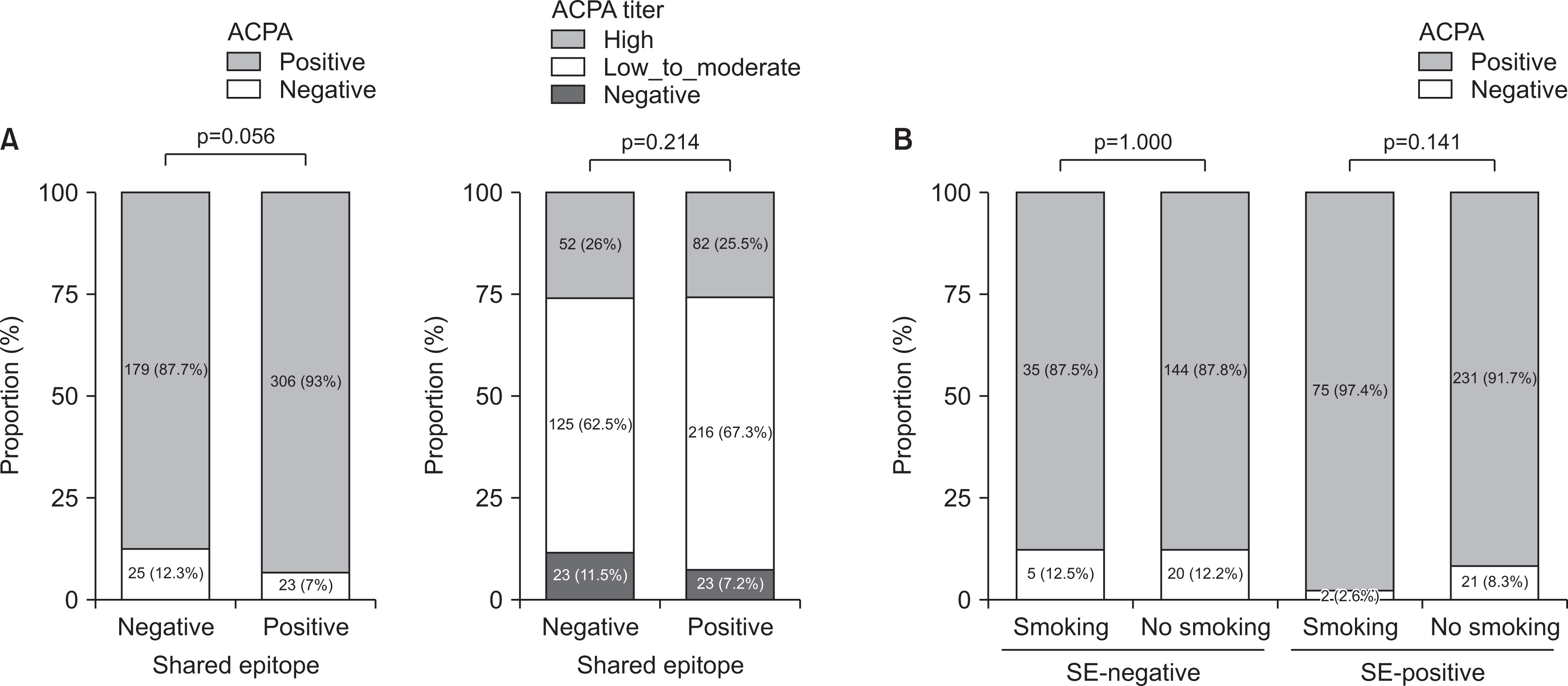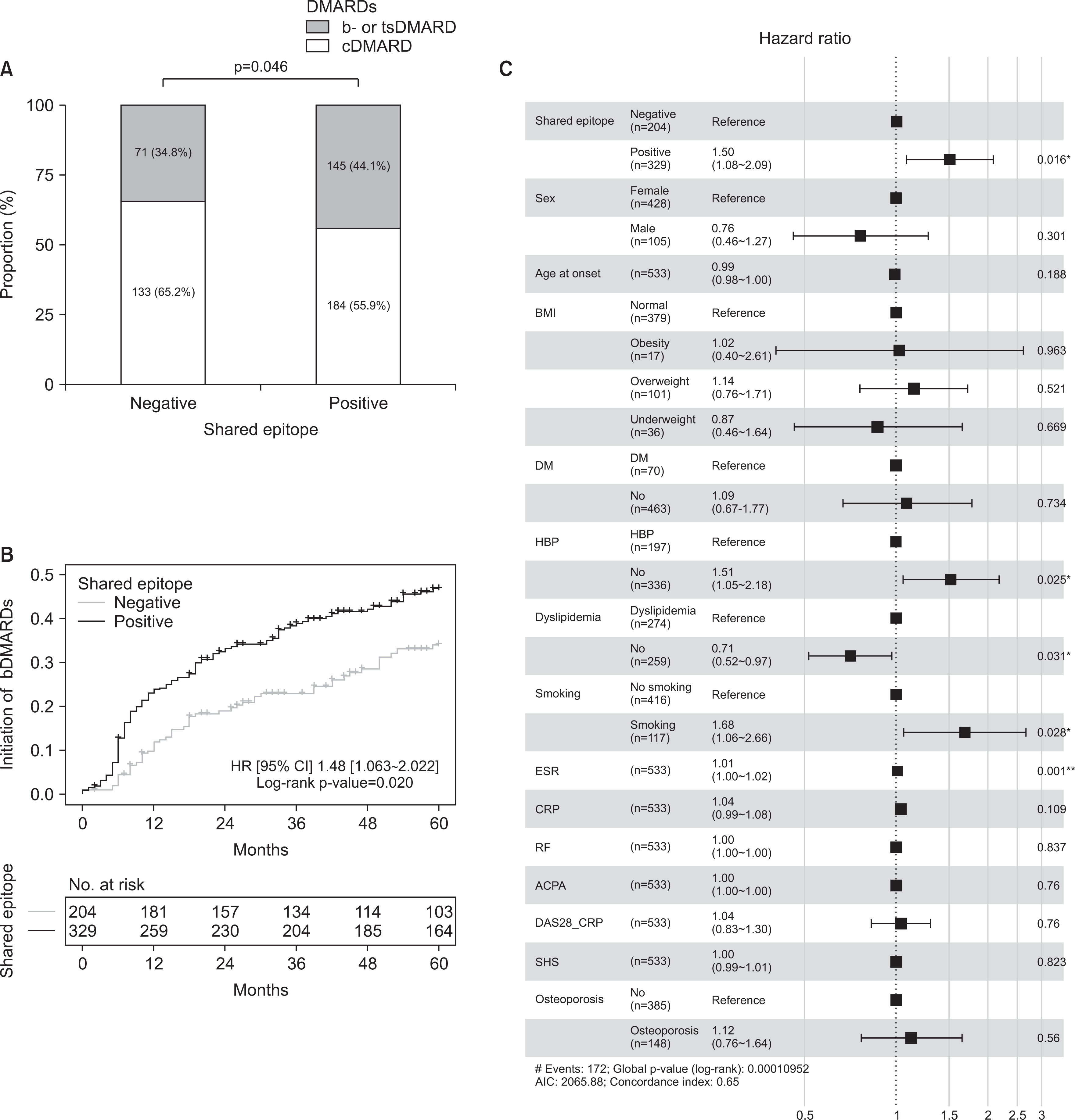1. Smolen JS, Aletaha D, Barton A, Burmester GR, Emery P, Firestein GS, et al. 2018; Rheumatoid arthritis. Nat Rev Dis Primers. 4:18001. DOI:
10.1038/nrdp.2018.1. PMID:
29417936.

2. Bang SY, Lee KH, Cho SK, Lee HS, Lee KW, Bae SC. 2010; Smoking increases rheumatoid arthritis susceptibility in individuals carrying the HLA-DRB1 shared epitope, regardless of rheumatoid factor or anti-cyclic citrullinated peptide antibody status. Arthritis Rheum. 62:369–77. DOI:
10.1002/art.27272. PMID:
20112396.
3. Gonzalez-Gay MA, Garcia-Porrua C, Hajeer AH. 2002; Influence of human leukocyte antigen-DRB1 on the susceptibility and severity of rheumatoid arthritis. Semin Arthritis Rheum. 31:355–60. DOI:
10.1053/sarh.2002.32552. PMID:
12077707.

4. Moreno I, Valenzuela A, García A, Yélamos J, Sánchez B, Hernánz W. 1996; Association of the shared epitope with radiological severity of rheumatoid arthritis. J Rheumatol. 23:6–9.
5. Too CL, Yahya A, Murad S, Dhaliwal JS, Larsson PT, Muhamad NA, et al. 2012; Smoking interacts with HLA-DRB1 shared epitope in the development of anti-citrullinated protein antibody-positive rheumatoid arthritis: results from the Malaysian Epidemiological Investigation of Rheumatoid Arthritis (MyEIRA). Arthritis Res Ther. 14:R89. DOI:
10.1186/ar3813. PMID:
22537824. PMCID:
PMC3446463.

6. Gregersen PK, Silver J, Winchester RJ. 1987; The shared epitope hypothesis. An approach to understanding the molecular genetics of susceptibility to rheumatoid arthritis. Arthritis Rheum. 30:1205–13. DOI:
10.1002/art.1780301102. PMID:
2446635.

7. Fu J, Nogueira SV, Drongelen VV, Coit P, Ling S, Rosloniec EF, et al. 2018; Shared epitope-aryl hydrocarbon receptor crosstalk underlies the mechanism of gene-environment interaction in autoimmune arthritis. Proc Natl Acad Sci U S A. 115:4755–60. DOI:
10.1073/pnas.1722124115. PMID:
29666259. PMCID:
PMC5939100.

8. Malmström V, Catrina AI, Klareskog L. 2017; The immunopathogenesis of seropositive rheumatoid arthritis: from triggering to targeting. Nat Rev Immunol. 17:60–75. DOI:
10.1038/nri.2016.124. PMID:
27916980.

9. Neogi T, Aletaha D, Silman AJ, Naden RL, Felson DT, Aggarwal R, et al. 2010; The 2010 American College of Rheumatology/European League Against Rheumatism classification criteria for rheumatoid arthritis: Phase 2 methodological report. Arthritis Rheum. 62:2582–91. DOI:
10.1002/art.27580. PMID:
20872596. PMCID:
PMC3077961.

10. Berglin E, Johansson T, Sundin U, Jidell E, Wadell G, Hallmans G, et al. 2006; Radiological outcome in rheumatoid arthritis is predicted by presence of antibodies against cyclic citrullinated peptide before and at disease onset, and by IgA-RF at disease onset. Ann Rheum Dis. 65:453–8. DOI:
10.1136/ard.2005.041376. PMID:
16176994. PMCID:
PMC1798112.

11. Syversen SW, Gaarder PI, Goll GL, Ødegård S, Haavardsholm EA, Mowinckel P, et al. 2008; High anti-cyclic citrullinated peptide levels and an algorithm of four variables predict radiographic progression in patients with rheumatoid arthritis: results from a 10-year longitudinal study. Ann Rheum Dis. 67:212–7. DOI:
10.1136/ard.2006.068247. PMID:
17526555.

12. Joo YB, Park YJ, Park KS, Kim KJ. 2019; Association of cumulative anti-cyclic citrullinated protein antibodies with radiographic progression in patients with rheumatoid arthritis. Clin Rheumatol. 38:2423–32. DOI:
10.1007/s10067-019-04554-w. PMID:
31049760.

14. Huizinga TW, Amos CI, van der Helm-van Mil AH, Chen W, van Gaalen FA, Jawaheer D, et al. 2005; Refining the complex rheumatoid arthritis phenotype based on specificity of the HLA-DRB1 shared epitope for antibodies to citrullinated proteins. Arthritis Rheum. 52:3433–8. DOI:
10.1002/art.21385. PMID:
16255021.

15. Jiang X, Frisell T, Askling J, Karlson EW, Klareskog L, Alfredsson L, et al. 2015; To what extent is the familial risk of rheumatoid arthritis explained by established rheumatoid arthritis risk factors? Arthritis Rheumatol. 67:352–62. DOI:
10.1002/art.38927. PMID:
25418518.

16. Klareskog L, Stolt P, Lundberg K, Källberg H, Bengtsson C, Grunewald J, et al. 2006; A new model for an etiology of rheumatoid arthritis: smoking may trigger HLA-DR (shared epitope)-restricted immune reactions to autoantigens modified by citrullination. Arthritis Rheum. 54:38–46. DOI:
10.1002/art.21575. PMID:
16385494.

17. Terao C, Yano K, Ikari K, Furu M, Yamakawa N, Yoshida S, et al. 2015; Brief report: main contribution of DRB1*04:05 among the shared epitope alleles and involvement of DRB1 amino acid position 57 in association with joint destruction in anti-citrullinated protein antibody-positive rheumatoid arthritis. Arthritis Rheumatol. 67:1744–50. DOI:
10.1002/art.39105. PMID:
25777156.

18. Smolen JS, Aletaha D. 2015; Rheumatoid arthritis therapy reappraisal: strategies, opportunities and challenges. Nat Rev Rheumatol. 11:276–89. DOI:
10.1038/nrrheum.2015.8. PMID:
25687177.

19. Gottenberg JE, Ravaud P, Cantagrel A, Combe B, Flipo RM, Schaeverbeke T, et al. 2012; Positivity for anti-cyclic citrullinated peptide is associated with a better response to abatacept: data from the 'Orencia and Rheumatoid Arthritis' registry. Ann Rheum Dis. 71:1815–9. DOI:
10.1136/annrheumdis-2011-201109. PMID:
22615458.

20. Sokolove J, Schiff M, Fleischmann R, Weinblatt ME, Connolly SE, Johnsen A, et al. 2016; Impact of baseline anti-cyclic citrullinated peptide-2 antibody concentration on efficacy outcomes following treatment with subcutaneous abatacept or adalimumab: 2-year results from the AMPLE trial. Ann Rheum Dis. 75:709–14. DOI:
10.1136/annrheumdis-2015-207942. PMID:
26359449. PMCID:
PMC4819608.

21. Alten R, Nüßlein HG, Mariette X, Galeazzi M, Lorenz HM, Cantagrel A, et al. 2017; Baseline autoantibodies preferentially impact abatacept efficacy in patients with rheumatoid arthritis who are biologic naïve: 6-month results from a real-world, international, prospective study. RMD Open. 3:e000345. DOI:
10.1136/rmdopen-2016-000345. PMID:
28243468. PMCID:
PMC5307376.

22. Harrold LR, Litman HJ, Connolly SE, Kelly S, Hua W, Alemao E, et al. 2018; Effect of anticitrullinated protein antibody status on response to abatacept or antitumor necrosis factor-α therapy in patients with rheumatoid arthritis: a US national observational study. J Rheumatol. 45:32–9. DOI:
10.3899/jrheum.170007. PMID:
29093151.

23. Alemao E, Postema R, Elbez Y, Mamane C, Finckh A. 2020; Presence of anti-cyclic citrullinated peptide antibodies is associated with better treatment response to abatacept but not to TNF inhibitors in patients with rheumatoid arthritis: a meta-analysis. Clin Exp Rheumatol. 38:455–66.
24. Griffiths B, Situnayake RD, Clark B, Tennant A, Salmon M, Emery P. 2000; Racial origin and its effect on disease expression and HLA-DRB1 types in patients with rheumatoid arthritis: a matched cross-sectional study. Rheumatology (Oxford). 39:857–64. DOI:
10.1093/rheumatology/39.8.857. PMID:
10952739.

25. Helliwell PS, Ibrahim G. 2003; Ethnic differences in responses to disease modifying drugs. Rheumatology (Oxford). 42:1197–201. DOI:
10.1093/rheumatology/keg354. PMID:
12810940.

26. Smolen JS, Landewé RBM, Bijlsma JWJ, Burmester GR, Dougados M, Kerschbaumer A, et al. 2020; EULAR recommendations for the management of rheumatoid arthritis with synthetic and biological disease-modifying antirheumatic drugs: 2019 update. Ann Rheum Dis. 79:685–99. DOI:
10.1136/annrheumdis-2019-216655. PMID:
31969328.
27. van Riel PL, Fransen J. 2005; DAS28: a useful instrument to monitor infliximab treatment in patients with rheumatoid arthritis. Arthritis Res Ther. 7:189–90. DOI:
10.1186/ar1820. PMID:
16207346. PMCID:
PMC1257454.
28. Seo DH, Lee JM, Park MO, Lee HJ, Moon SY, Oh M, et al. 2018; Development of HLA-A, -B and -DR typing method using next-generation sequencing. Korean J Blood Transfus. 29:310–9. DOI:
10.17945/kjbt.2018.29.3.310.

29. Fisher BA, Bang SY, Chowdhury M, Lee HS, Kim JH, Charles P, et al. 2014; Smoking, the HLA-DRB1 shared epitope and ACPA fine-specificity in Koreans with rheumatoid arthritis: evidence for more than one pathogenic pathway linking smoking to disease. Ann Rheum Dis. 73:741–7. DOI:
10.1136/annrheumdis-2012-202535. PMID:
23505239.

30. Hecht C, Englbrecht M, Rech J, Schmidt S, Araujo E, Engelke K, et al. 2015; Additive effect of anti-citrullinated protein antibodies and rheumatoid factor on bone erosions in patients with RA. Ann Rheum Dis. 74:2151–6. DOI:
10.1136/annrheumdis-2014-205428. PMID:
25115448.

32. Lundström E, Källberg H, Alfredsson L, Klareskog L, Padyukov L. 2009; Gene-environment interaction between the DRB1 shared epitope and smoking in the risk of anti-citrullinated protein antibody-positive rheumatoid arthritis: all alleles are important. Arthritis Rheum. 60:1597–603. DOI:
10.1002/art.24572. PMID:
19479873. PMCID:
PMC2732897.

33. Willemze A, van der Woude D, Ghidey W, Levarht EW, Stoeken-Rijsbergen G, Verduyn W, et al. 2011; The interaction between HLA shared epitope alleles and smoking and its contribution to autoimmunity against several citrullinated antigens. Arthritis Rheum. 63:1823–32. DOI:
10.1002/art.30409. PMID:
21506097.

34. Teitsma XM, Jacobs JWG, Welsing PMJ, de Jong PHP, Hazes JMW, Weel AEAM, et al. 2018; Inadequate response to treat-to-target methotrexate therapy in patients with new-onset rheumatoid arthritis: development and validation of clinical predictors. Ann Rheum Dis. 77:1261–7. DOI:
10.1136/annrheumdis-2018-213035. PMID:
29760159.

35. Mattey DL, Hassell AB, Dawes PT, Cheung NT, Poulton KV, Thomson W, et al. 2001; Independent association of rheumatoid factor and the HLA-DRB1 shared epitope with radiographic outcome in rheumatoid arthritis. Arthritis Rheum. 44:1529–33. DOI:
10.1002/1529-0131(200107)44:7<1529::AID-ART275>3.0.CO;2-P.

36. Wysocki T, Olesińska M, Paradowska-Gorycka A. 2020; Current understanding of an emerging role of HLA-DRB1 gene in rheumatoid arthritis-from research to clinical practice. Cells. 9:1127. DOI:
10.3390/cells9051127. PMID:
32370106. PMCID:
PMC7291248.

37. Criswell LA, Lum RF, Turner KN, Woehl B, Zhu Y, Wang J, et al. 2004; The influence of genetic variation in the HLA-DRB1 and LTA-TNF regions on the response to treatment of early rheumatoid arthritis with methotrexate or etanercept. Arthritis Rheum. 50:2750–6. DOI:
10.1002/art.20469. PMID:
15457442.
38. Oryoji K, Yoshida K, Kashiwado Y, Tanaka K, Mizuki SI, Tsukamoto H, et al. 2018; Shared epitope positivity is related to efficacy of abatacept in rheumatoid arthritis. Ann Rheum Dis. 77:1234–6. DOI:
10.1136/annrheumdis-2017-eular.5586.

39. Neovius M, Arkema EV, Olsson H, Eriksson JK, Kristensen LE, Simard JF, et al. 2015; Drug survival on TNF inhibitors in patients with rheumatoid arthritis comparison of adalimumab, etanercept and infliximab. Ann Rheum Dis. 74:354–60. DOI:
10.1136/annrheumdis-2013-204128. PMID:
24285495. PMCID:
PMC4316855.








 PDF
PDF Citation
Citation Print
Print



 XML Download
XML Download